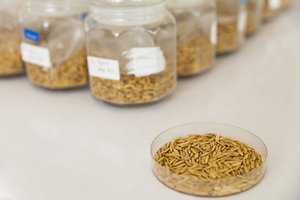
CRISPR-Mediated Editing of Rice False Smut Fungus
June 6, 2018| |
 The fungus Ustilaginoidea virens causes rice false smut, a major disease of rice (Oryza sativa). However, there are only limited molecular studies on this pathogen due to the lack of techniques for studying targeted gene disruption mutants. The research team of Yafeng Liang from the Northwest A&F University in China used the CRISPR-Cas9 system to generate mutants with deleted USTA ustiloxin and UvSLT2 MAP kinase genes.
The fungus Ustilaginoidea virens causes rice false smut, a major disease of rice (Oryza sativa). However, there are only limited molecular studies on this pathogen due to the lack of techniques for studying targeted gene disruption mutants. The research team of Yafeng Liang from the Northwest A&F University in China used the CRISPR-Cas9 system to generate mutants with deleted USTA ustiloxin and UvSLT2 MAP kinase genes.
Three gRNAs targeting USTA, namely UA01, UA13, and UA21, were transformed into U. virens. For all three, the gene replacement frequency was higher when the Cas9 and gRNA constructs were transformed on the same vector. UA01 had the highest knockout frequency of 90% for generating ustA mutants. No off-target mutations were detected in the ustA mutants generated via any of the three gRNAs.
For UvSLT2, the gene replacement frequency was 50% with CRISPR-Cas9. While ustA mutants had no detectable phenotypes, Uvslt2 mutants had slightly reduced growth rate and had over 70% reduction in conidiation. Deletion of UvSLT2 also increased sensitivity to cell wall stresses but tolerance to hyperosmotic or oxidative stresses.
These results showed that the CRISPR-Cas9 system can be used as an efficient gene editing approach in U. virens and could be used to develop varieties resistant to false smut.
For more information, read the article in Frontiers in Plant Science.
| |
Biotech Updates is a weekly newsletter of ISAAA, a not-for-profit organization. It is distributed for free to over 22,000 subscribers worldwide to inform them about the key developments in biosciences, especially in biotechnology. Your support will help us in our mission to feed the world with knowledge. You can help by donating as little as $10.
-
See more articles:
-
News from Around the World
- World Seed Congress Highlights Industry's Mission to Unlock the Power of Genetics
- Malawi Releases New Seed Policy
- Journalists Urged to Do Quality Reporting on Science and Technology
- Ethiopia Approves Environmental Release of Bt Cotton and Grants Special Permit for GM Maize
- Scientists Use Big Data to Map Corn's Response to Heat Stress
- Indian Farmers Use Whatsapp and Facebook to Demand GM Seeds
- ICRISAT and NRGene Make Chickpea and Pigeonpea Reference Genome Data Available
- Report Shows Costs of Chinese Delays on Biotech Crop Approvals
- European and French Studies Disprove Seralini's GM Maize Claims
-
Research Highlights
- Transgenic Cotton Allows Selective Fertilization for Weed Control
- Scientists Engineer Safflower to Produce Healthier Oil
- Scientists Discover the Role of Isopentenyltransferase in Lycopene Synthesis in Tomato
-
Announcements
- IAPB2018
-
Resources
- The Promise of Genome Editing Tools to Advance Environmental Health Research
-
Plant
- Transcription Factor Controlling Production of Secondary Cell Walls Found in Rice
- Chinese Scientists Develop Fungus-Resistant Cotton
- Researchers Analyze the Function of TaGW2 Genes in Wheat Grain Traits
- CRISPR-Mediated Editing of Rice False Smut Fungus
-
Read the latest: - Biotech Updates (October 15, 2025)
- Gene Editing Supplement (September 24, 2025)
- Gene Drive Supplement (February 22, 2023)
-
Subscribe to BU: - Share
- Tweet
